The Expo Affair
A True Story by Neil F. Comins
Three years ago, Neil was contacted by
Shuji Abe, the president of movie production studio
Robot Communication
in Japan. Mr. Abe had just read the
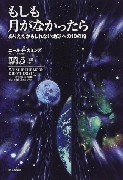 Japanese-language version of Neil’s book,
What if the Moon Didn’t Exist?
Japanese-language version of Neil’s book,
What if the Moon Didn’t Exist?
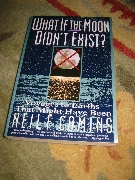 and thought that it would be a good theme for the Mitsubishi
pavilion at the World Expo
2005. Mr. Abe (Abe-san, in Japanese)
asked if Neil would work with his company to pitch the idea in response to a
request for ideas from Mitsubishi. Neil
agreed and the concept was chosen from a field of over 30 proposals.
and thought that it would be a good theme for the Mitsubishi
pavilion at the World Expo
2005. Mr. Abe (Abe-san, in Japanese)
asked if Neil would work with his company to pitch the idea in response to a
request for ideas from Mitsubishi. Neil
agreed and the concept was chosen from a field of over 30 proposals.
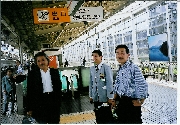
Neil went to Japan twice to work with the production team to develop the show.
During one of those trips, Abe-san and two of his movie producers, Chikara Saito
and Taki Kabuto, took
Neil to visit the shrines at Kyoto. The trip was a moving experience, during
which we visited 5 shrines,
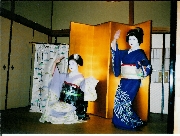
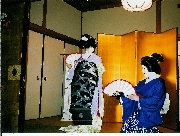
stayed in a Ryokan (traditional Japanese inn), and were entertained by geishas.
Neil’s room at the Ryokan
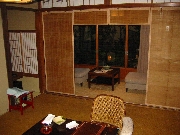
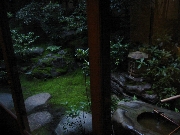
was the room that is used by heads of state, Nobel laureates, major entertainers, and
other dignitaries.
After the
second trip, Neil worked from home on the script and signed off on it in the
middle of 2004. Expo 2005 opened on
March 25 and will run through September 25 of this year, 2005. We were invited to visit Expo during the week
of April 3 and so Sue and Neil left for Japan
on April 2 and arrived on April 3.
The trip from Detroit to
Narita airport took over 13 hours, so flying business class made it much less
exhausting and stressful than it would otherwise have been. We arrived around 4
PM local time (2 AM Eastern Standard Time) and caught the
Limousine Bus
 – just a bus, as
you can see – to the
Imperial Hotel
in Tokyo, about an hour and a
half away.
– just a bus, as
you can see – to the
Imperial Hotel
in Tokyo, about an hour and a
half away.
Monday
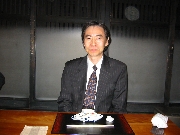
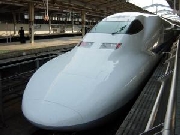
On Monday morning, we were met by
Yoshi Yamakawa, director general
of the Mitsubishi pavilion, who escorted us to the resort/shrine town of Nikko
north of Tokyo. We took the
shinkansen (bullet train)
first to the industrial town of Utsonomiya,
where we stopped for a memorable lunch at a hotel (good restaurants being
otherwise hard to find there). Then we
took another shinkansen and finally a local train to Nikko.
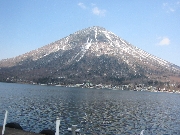
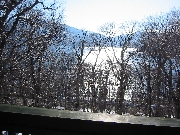
From there we got a limo for a ride
to Lake Chuzenji. The drive was rather
interesting. On our way out of town, we
saw two golden-colored monkeys lounging near the road. These Japanese monkeys, numbering over
150,000 throughout the country, are so numerous that they have become a
nuisance in some areas, such as Nikko,
where feeding them is now banned.
Nevertheless, to a tourist they look exotic and interesting. The drive up the mountain to Lake
Chuzenji
is very famous in Japan. The one-way road has 20 hairpin turns going
up and 28 such turns going down. There
are also 48 letters in one of the Japanese alphabets, so each turn is given its
own letter.
While the temperature was in the
50s in Tokyo, there was snow on the
ground at lake
Chuzenji,
which is located in a volcanic crater.
We stayed in the Chuzenji Kanaya Hotel, which is
built in the style of a western Canadian log-style hotel.
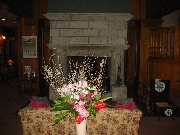
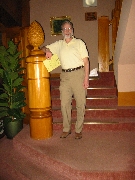 It has a walk-around fireplace
in the common area and a hot spring spa outside. Getting to the spa requires changing footwear in the hotel, walking outside
in the cold for about 30 yards, and then entering the spa building. As you probably know, the etiquette of using
a spa is that you soap and rinse yourself well before entering the water,
naked. As is becoming more the custom,
the spa has separate baths for men and women.
These are sulfur spring waters; the odor is an acquired taste. We soaked first in an inside bath and then went
quickly into an outside bath and then back again. The view of the lake at sunset from the
outside bath is really stunning.
It has a walk-around fireplace
in the common area and a hot spring spa outside. Getting to the spa requires changing footwear in the hotel, walking outside
in the cold for about 30 yards, and then entering the spa building. As you probably know, the etiquette of using
a spa is that you soap and rinse yourself well before entering the water,
naked. As is becoming more the custom,
the spa has separate baths for men and women.
These are sulfur spring waters; the odor is an acquired taste. We soaked first in an inside bath and then went
quickly into an outside bath and then back again. The view of the lake at sunset from the
outside bath is really stunning.
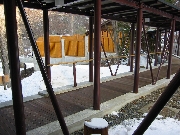
Tuesday
The next day we drove first to Kegon
Falls.
There were very interesting rock formations
along the cliffs, which Neil is still
trying to identify.
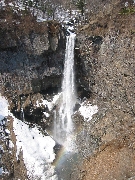
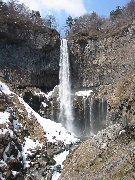
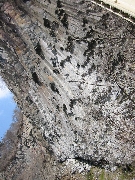
The next stop was the
Toshogu
shrine at Nikko. It is the mausoleum
of the first Tokugawa shogun, Ieyasu, and is an incredible display of art, carpentry,
and architecture.
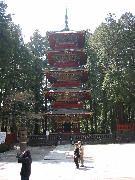
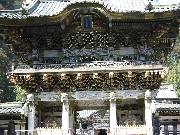
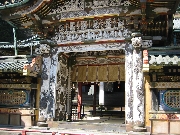
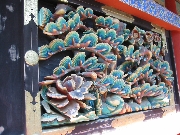
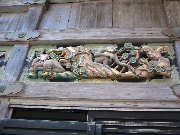
It was built around 1616
and has, among other things, the theme of the 3 monkeys: speak no evil, hear no
evil, see no evil. Our guide, a man in
his seventies, introduced himself as a “local boy with a high school
education.” He spoke excellent English
and was extremely knowledgeable about all the details of the shrine. As with all the people who helped us on the
trip, Sue gave him a small gift after we were done. Our final stop in Nikko,
for a traditional Japanese lunch, was the Nikko Kanaya
hotel, which has hosted such notables as Einstein, Gandhi, Eleanor
Roosevelt, and several emperors of Japan.
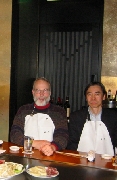
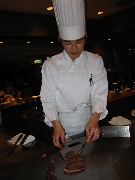
The teppenyaki
dinner on Tuesday night took place at the Kamon grill
back at the Imperial hotel.
Yoshi had invited
his wife to join us. This is actually
quite unusual in Japan
– business acquaintances rarely get to meet other family members. She recognized Neil from a TV spot that had
been aired that week.
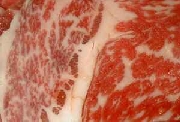 Among the other
dishes we had was Kobe beef.
You probably know that these are massaged,
beer-fed animals whose meat is extremely marbled
(read that “especially high in fat and
cholesterol”, but very delicious).
Dinner was followed by a shinkansen ride to Nagoya
the same evening.
Among the other
dishes we had was Kobe beef.
You probably know that these are massaged,
beer-fed animals whose meat is extremely marbled
(read that “especially high in fat and
cholesterol”, but very delicious).
Dinner was followed by a shinkansen ride to Nagoya
the same evening.
Back in 1981, we befriended a
Japanese woman, Teruyo Uozomi, and her two children
when we were all at Stanford University. Neil was doing astronomy research and Sue and
Teruyo, an English teacher in Japan,
were taking a linguistics course. Sue
has kept in touch with Teruyo over the years.
The children are now business people in Tokyo,
but Teruyo and her husband, Toshihiro, still live in Nagoya. We had never really expected to see them
again, but because of this trip, we were able to. Not only that, but they invited us to stay in
their house, which is also a rare treat in Japan,
where living accommodations are often “cozy” by American standards. She met us at the station and except for
having shorter hair, Teruyo looked very much as she had 24 years ago.
We took a taxi to their home. Nagoya,
the fourth largest city in Japan,
has 2 million people, and like the other big cities, is filled with narrow,
winding streets in the residential districts.
Their home was located on a crowded, steep hillside in an extremely
affluent neighborhood. Their home, of
about 2000 square feet indoor space plus a thousand square feet of well-tended
gardens, filled the lot. The house was
architect-designed and made of poured concrete, rather than traditional wood
materials. It was already quite late,
and after an hour of catching up, we went to bed. Teruyo is a student of the tea ceremony, and
we slept in the tatami and bamboo-lined room that she
uses for that purpose.
Wednesday
Wednesday
was scheduled for Neil and Sue to spend with the Uozomis. One thing that Neil learned early on in his
working with Japanese business people is that times are scheduled down to the
minute. Wednesday was our least-scheduled
day. Neil went to the Expo with
Toshihiro. Getting there is a simple
matter of taking the original subway to the end of its line and getting on a
specially-built subway that goes to the Expo grounds. What makes the trip special is that the new
subway to the Expo uses magnetic levitation to lift and move the carriages. It
is called linimo,
short for linear induction motor. The
linimo has no wheels. Rather, it floats
above the track and is very powerful and smooth.
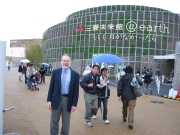
As at the
1964 World’s Fair, the major
attractions at World Expo 2005 are the corporate pavilions. They only have about 9 corporate pavilions
because the fair grounds are relatively small.
Back in ’64, Neil mostly went to corporate pavilions; therefore he
decided to spend Wednesday going to the country pavilions. The Middle East group were closest to the
entry to Expo so he and Toshihiro started with them.
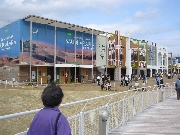
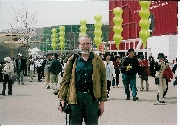
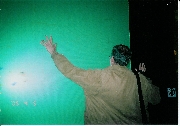
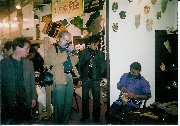
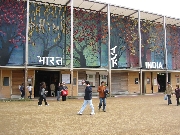
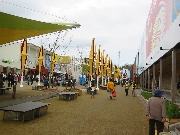
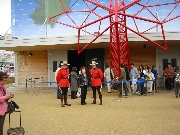
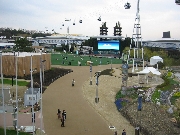
Each Expo has had a
theme. The theme of this one is
“Nature’s Wisdom” and the importance of balancing our global growth with the
need to sustain the planet. While much
of the art displayed in many of the pavilions was truly world class, many of
these pavilions in the Middle East group were centered
on marketing their wares. Several
pavilions each had dozens of people making and selling thousands of pieces of
jewelry, clothing, pottery, and art pieces.
It was interesting to get a feel for what the markets in these countries
were like, but still… .
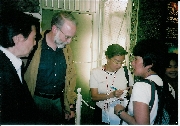
The Boston
Globe had sent a reporter (stationed in Tokyo)
and a photographer (stationed in Boston)
to visit the Expo and prepare an article on what to visit for the Globe. From a Japanese travel agent in Boston,
they had learned of Neil’s contribution to the Mitsubishi pavilion and had
contacted him about a month before the trip to Japan. Amazingly, they were going to be “doing” the
Expo on this day and they had arranged to meet Neil and go through the
Mitsubishi pavilion with him. Thanks to
the power of cell phones, they
met
on time, at 2 PM, and went through the pavilion
together. English-language portable
headsets allow Westerners to make sense of the story. As with most people visiting the Expo, the
reporter and photographer were very impressed with the show, as well as the
fact that the pavilion was made of environment-friendly materials that will be
easily disposed of when the run of 165 days is over.
Toshihiro
had a 3 PM appointment, so Neil spent
the rest of the day by himself at Expo.
He visited all 5 non-corporate areas (zones) of the Expo (there are
about 8 zones all together, depending on how you count them). They are connected by a broad board
walk. For people who need or want to
ride, there is a red bus-like affair, similar to the ones that carry visitors
from the parking area to the theme parks at Disneyland. The Expo bus, however, has a person walking
in front of it warning pedestrians to get out of the way.
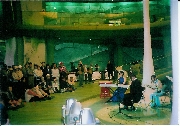
Neil’s favorite pavilions included
the Chinese for the exquisite
live music, the Czech Republic
for its demonstrations of the relationships between music and art, the Swiss pavilion, the Australian pavilion,
and the Singapore
pavilion. In a cubical theater showing
images on all sides except the floor, France’s
pavilion had a very edgy, disturbing film about how we are polluting the
planet. Don’t ask about the US
pavilion.
Late in the day, Neil took the
cable car for a bird’s eye view of the Expo.
The lights were coming on and the Expo looked like it was coming to
life. Later, sitting on a bench and
eating a snack (it is not considered good taste to walk around and eat in Japan),
Neil was able to bring back vivid images of the NY World’s Fair. Navigating back to the Chikusa district of
Nagoya alone was an adventure, but he arrived back at the Uozomi’s
home in time for dinner and a long evening of catching up on the past 24 years.
Thursday
Thursday
was the beginning of “business,” with Neil, Sue, and Teruyo traveling to the
Mitsubishi pavilion at Expo shortly after it opened, at 10 AM. They were
met by a film crew from NHK, who filmed Neil going through the pavilion. Some of this footage was aired the next
evening nationwide.
The show
consists of 3 parts.
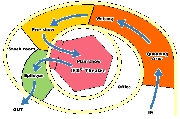 First is a brief introduction under cover,
but not indoors, by two robots of a model called Wakamaru
that will be marketed for the first time next year. This part of the show is just in Japanese,
but the rest has the foreign-language translations mentioned above. Kids are fascinated by the robots that are
seen in many pavilions at Expo, most notably Toyota,
which has an ensemble of them playing trumpets and other instruments. Neil enjoyed seeing kids waving to Wakamaru.
First is a brief introduction under cover,
but not indoors, by two robots of a model called Wakamaru
that will be marketed for the first time next year. This part of the show is just in Japanese,
but the rest has the foreign-language translations mentioned above. Kids are fascinated by the robots that are
seen in many pavilions at Expo, most notably Toyota,
which has an ensemble of them playing trumpets and other instruments. Neil enjoyed seeing kids waving to Wakamaru.
The second
part of the show is the science part, in which the What if the Moon Didn’t
Exist? question is set up and asked. Neil had “significantly” reworked the script
for the show back in 2004 and he was delighted that the producer had kept the
script, and therefore the science in the script, completely intact. Everything made sense scientifically and the
other people working on the project had made a very entertaining show to follow
up on the consequences of the “What if?” question.
The finale takes place in a theater seating 300 people. It is here that
the world without the Moon is explored and compared to the world as it is. Neil has named the moonless Earth Solon. Solon would have an 8 hour day, winds much
higher than we experience, and a surface that would shake violently as Solon occasionally
and unpredictably wobbled on its axis.
The idea of the pavilion is to show that compared to other, plausible
worlds, like Solon, Earth is a very hospitable place for life and that we need
to work hard to keep it that way. (The
collision that created the Moon and helped make the Earth so user-friendly
almost didn’t happen. If that other body
had been in an orbit that varied by inches from its actual orbit, then it would
have eventually changed its path so much as to miss the Earth. This is the same science, chaos theory, that
explains the unpredictability of the weather.
The point is that if we humans make a small change on Earth today, it
could well have major, unpredictable, undesirable consequences. We must be careful as stewards of the planet.) BTW, Neil and his son James thought up an
interesting sci fi story about Solon that one of them will eventually write as
a novel.
The theater has 6 sides,
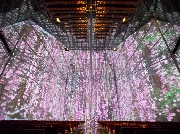 three of which are normal
movie theater screens, two of which are mirrors, and the one behind the
audience is a normal wall. Floor and
ceiling are also mirrors. Curtains hide
all but the front wall at first. For the
last five or ten minutes, the curtains draw back and if you look at the mirror
sides, you can see multiple reflections which gives a 3-D feeling to the
show. While Neil has had TV shows, radio
shows, and even planetarium shows developed based on his writings, this
pavilion is by far the most spectacular and creative work based on them to
date. They even had music commissioned for
the pavilion and the Brothers 4 (remember
them?) wrote a piece for the pavilion based on the theme of Neil’s book. Quite honestly, the whole thing brought tears
to our eyes.
three of which are normal
movie theater screens, two of which are mirrors, and the one behind the
audience is a normal wall. Floor and
ceiling are also mirrors. Curtains hide
all but the front wall at first. For the
last five or ten minutes, the curtains draw back and if you look at the mirror
sides, you can see multiple reflections which gives a 3-D feeling to the
show. While Neil has had TV shows, radio
shows, and even planetarium shows developed based on his writings, this
pavilion is by far the most spectacular and creative work based on them to
date. They even had music commissioned for
the pavilion and the Brothers 4 (remember
them?) wrote a piece for the pavilion based on the theme of Neil’s book. Quite honestly, the whole thing brought tears
to our eyes.

After the main show is the sales
room, where all sorts of edibles, toys, and
Neil’s book in Japanese
are marketed.
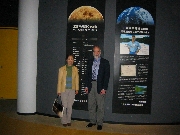 There is also a picture of
Harrison Ford
in support of some aspect of the project.
There is also a picture of
Harrison Ford
in support of some aspect of the project.
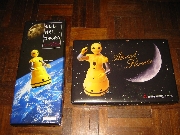
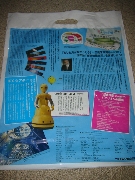
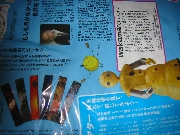 Mitsubishi went so far as to have wrapping paper
and shopping bags made in the theme of the pavilion.
It’s quite interesting to see your picture on thousands of
shopping bags! Yoshi explained that the
marketing people had expected very few of the books to be sold because they are
“scientific” rather than entertaining, even though they are written for the
public. It turned out that the marketing
people were wrong. In the first two
weeks, over 500 copies of the book were sold at the pavilion.
Mitsubishi went so far as to have wrapping paper
and shopping bags made in the theme of the pavilion.
It’s quite interesting to see your picture on thousands of
shopping bags! Yoshi explained that the
marketing people had expected very few of the books to be sold because they are
“scientific” rather than entertaining, even though they are written for the
public. It turned out that the marketing
people were wrong. In the first two
weeks, over 500 copies of the book were sold at the pavilion.
Immediately after the show, we were
escorted to the Hotel Okura Chinese restaurant for a sumptuous lunch. In the middle of the meal there was a knock
at the door and someone entered and asked Neil if he was expecting guests,
which he wasn’t. He excused himself and
went outside to find two women from Hiroshima
waiting for him. He recognized them, but
couldn’t believe that they had found him.
Herein lies another story:
In the Fall of
2003, Neil was contacted by one of the 3 directors of the Mitsubishi pavilion,
Makoto Ohara, whom Neil had gotten to know on his earlier visits to Japan. Ohara-san asked if Neil would be willing to
give a talk to visitors from Japan
who would be coming to the States in the summer of 2004. If so, some of those visitors would travel to
Bangor to stay with American
families for 3 nights, visit Acadia National
Park, and attend the lecture. The visits were to be arranged under the
auspices of
the John Manjiro-Whitfield Center for
International Exchange. Neil
agreed.
The opening
ceremonies for the meeting were held at the JFK Memorial Library in Boston
on Thursday, July 15, 2004. About 75 people had come from Japan
for a long weekend visit to the states. Neil
attended the ceremony, where he met Makihara-san, retired CEO of Mitsubishi
Heavy Industries, and other luminaries. Neil
only speaks a little Japanese, but he did understand a simple joke made in
Japanese by Makihara-san. It went like
this: After he and Neil talked about the upcoming World Expo, Makihara-san was
invited to give a speech. It was about 7
in the evening and he got up to the microphone and said, “ohayougozaimasu,” [which
means, “good morning”] and then in English he added, “I just flew in from Japan
and am still on Japanese time”.
After the opening
ceremonies, the participants went to one of about a dozen venues around New
England, including Bangor. On Sunday, Neil gave his talk to seven people
from Japan,
including Ohara-san, from the Mitsubishi pavilion, and two women from Hiroshima
named Setsuko and Keiko, among others.
Following a lunch after the talk, the group returned to Boston
and then Japan.
Quite honestly, Neil never expected
to see any of the group that visited Bangor,
except Ohara-san, again.
But there Setsuko and Keiko were, at the Hotel Okura pavilion in
Nagoya,
waiting for him outside the banquet room.
Excited greetings followed and they explained how they knew that Neil
would be here. It turns out that
Ohara-san had kept in touch with them after they had returned to Japan the
previous summer. Since he knew Neil’s
itinerary, he let them know when Neil and Sue would be at the Expo. They e-mailed Neil, asking to see him, but
that was only the day before the visit to the Expo and Neil didn’t have his
computer to check his messages, so he didn’t reply.
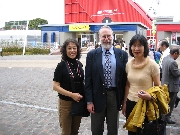 Nevertheless, they traveled up to the Expo on
the day of Neil’s visit and, with Ohara-san’s help,
tracked
him down.
Nevertheless, they traveled up to the Expo on
the day of Neil’s visit and, with Ohara-san’s help,
tracked
him down.
After lunch, Sue went off to see
different pavilions and Neil, Yoshi, and Teruyo were off to meet the secretary
general of the Expo, Toshio Nakamura. He
is the gentlemen who had hands-on supervision of the creation of the Expo. His waiting room had in it the most
wonderfully scented lilies, possibly Stargazer lilies. Their aroma will always hold a connection to
the Expo for Neil.
Then came a press conference, with
about 30 reporters and photographers.
They asked a variety of questions, the last of which was the most
interesting, namely what if the Sun didn’t exist? Then came questions submitted on the internet
by children who had visited the Expo.
The press conference ended with a round of applause, which is presumably
SOP.
As soon as the first press
conference was over, we went quickly across the Expo grounds to the Global
House, where Neil was interviewed by about 20 children who were learning to be
reporters. They had just seen the
Mitsubishi pavilion and had prepared questions that he answered through an
interpreter. After the interview, the
children went into a production room where they made a newspaper.










The Global House also contains the
remains of a wooly mammoth recovered from Siberia. Since we were already there, the director of
the pavilion took us through to the mammoth exhibit without having to wait on
line. They insure that people don’t
spend too long viewing the mammoth by having the viewing line move on a moving
floor, like in an airport. One minute’s
viewing time and you are out of there. On
display were the head and one foot of a frozen wooly mammoth, both kept in a
refrigerated, glass-lined unit.
Everyone connected with the
Mitsubishi pavilion seemed satisfied with the day’s events. Around 4 PM,
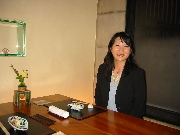 Sue returned to the Mitsubishi pavilion and after a final walk around and talk
with people, Neil and Sue took their leave of the Expo, accompanied by Teruyo,
Yoshi, and Yuka
Fukahara, the architect of the pavilion’s interior. Another ride on the linimo brought them to a
waiting van, which drove them to Teruyo’s house to pick up luggage. This is not a trivial thing, since the house
is on a street that is only barely able to fit one car, and on a steep slope,
to boot.
Sue returned to the Mitsubishi pavilion and after a final walk around and talk
with people, Neil and Sue took their leave of the Expo, accompanied by Teruyo,
Yoshi, and Yuka
Fukahara, the architect of the pavilion’s interior. Another ride on the linimo brought them to a
waiting van, which drove them to Teruyo’s house to pick up luggage. This is not a trivial thing, since the house
is on a street that is only barely able to fit one car, and on a steep slope,
to boot.
From there, Neil, Sue, Yoshi, and
Yuka went to Yume-Usagi restaurant for an exquisite, traditional, many course,
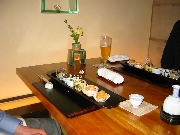 Japanese dinner. This restaurant is typical of many in the
cities of Japan,
in that it is in a tiny, 19th century building completely surrounded
by modern apartment and office buildings.
Sue gave Yuka a gift while we were there and, due to a rush at the end
to make a train, the gift was left in the restaurant. In the States, of course, unless we
remembered it and called them immediately, the gift would have been lost. In this case, however, a few minutes after we
left, a call came on Yoshi’s cell phone from Ohara-san, that the restaurant had
called Ohara and reported that the gift was still there. Arrangements were then made to have it picked
up the next day. Neil and Yoshi took a
late shinkansen back to Tokyo,
while Sue spent a final evening with the Uozomis.
Japanese dinner. This restaurant is typical of many in the
cities of Japan,
in that it is in a tiny, 19th century building completely surrounded
by modern apartment and office buildings.
Sue gave Yuka a gift while we were there and, due to a rush at the end
to make a train, the gift was left in the restaurant. In the States, of course, unless we
remembered it and called them immediately, the gift would have been lost. In this case, however, a few minutes after we
left, a call came on Yoshi’s cell phone from Ohara-san, that the restaurant had
called Ohara and reported that the gift was still there. Arrangements were then made to have it picked
up the next day. Neil and Yoshi took a
late shinkansen back to Tokyo,
while Sue spent a final evening with the Uozomis.
Late that night, Neil moved back
into the Imperial Hotel in preparation for a talk the next noontime to a group
of 30 of Tokyo’s top business
leaders, including the President of Kirin Brewery Co, the Chairman of the Bank
of Tokyo, and many Presidents and CEOs of the various Mitsubishi Corporations.
Friday
The talk was on the topic of the
pavilion, “What if the Moon Didn’t Exist?”. Neil wrote it months ahead of time and sent
it to Tokyo for translation by a
translator who was to accompany him to the meeting. Neil was told that the talk was the right
length. One thing that Neil wanted to
demonstrate to this august group of businessmen (yes, all men) was the way that
the Earth’s rotation axis changes direction slowly, over thousands of
years. This effect, called precession,
causes the location of the North pole to drift away
from Polaris, to return some 26,000 years later. The reason to show this is because without
the Moon, the Earth won’t precess as it does now, but
rather will wobble, sometimes violently, causing all kinds of havoc on the
Earth’s surface. To show this, Neil tried
to get a toy gyroscope or top, but there wasn’t one to be had in Bangor,
Maine.
He notified Tokyo and so you
can imagine his surprise when, just before the lunch that preceeded
the talk, the director of the talk program emptied a bag of toy tops on the
table and asked if any would be appropriate.
One of them was perfect and Neil practiced spinning it and having
it precess, just as the Earth does.
Minutes before the talk was to
begin, Neil was pulled aside by Yoshi and told that the director of the talk
program had looked at the talk again and thought that it was too long. Would he, Neil, please shorten it because it must be done at precisely 1:30 PM.
Paragraphs and phrases were deleted and passed to the translator so that
she could annotate her copy. Then began the first talk by a westerner to this group in its 50
year history. And it went
well! With only one or two minor pauses
throughout, Neil gave a talk to high-powered businessmen. At the end, Neil invited questions. Traditionally, none are asked, but he was
asked four good ones, and received two rounds of applause.
Back at the hotel, Neil said
farewell to Yoshi. It was 1:45 and his next meeting, at 2 PM, was with Kiyoshi Asano, book agent in Tokyo. Kiyoshi had sold one of Neil’s books, Heavenly Errors, to a publisher in Tokyo,
Kodansha. Kiyoshi asked to be allowed to
represent any other works Neil cares to sell in Japan. This may happen.
Sue arrived shortly before 4 PM.
She and a young woman named Miki (the one in the picture of Neil talking
to children) had traveled to Tokyo
that AM, courtesy of Mitsubishi, and had spent the day shopping and
sightseeing. Their taxi driver had taken
them to see the best places for viewing the cherry blossoms. At 4 PM a limo (Toyota Century) picked us up and took us to
the Ebisu district of Tokyo and the new headquarters
of Robot Communications Inc.,
the company owned by Shuji Abe. You may recall from the beginning of the
narrative that Abe-san was the one who started the whole collaboration with
Mitsubishi in the first place.
Abe-san and Neil have become very
good friends over the years, having spent several days touring Japan
with various luminaries in the Japanese movie industry. Abe-san has recently built a new office for
his entire company, consolidating them from their original two buildings. He gave Sue and Neil a tour of the building,
during which time Neil had the opportunity to see several old friends and Sue
got to meet Tatsutoshi Nomura, creator of the Stray
Sheep, a Japanese TV cartoon and book series for children. Nomura-san showed us his latest creation,
clay snails with houses on their backs.
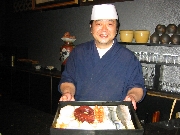 After the tour, Neil, Sue, Abe, and
3 of his staff went to dinner at Ygkou Rakuo sushi restaurant. This was Neil’s
third visit to this tiny establishment, where fresh fish is brought in every
day and the food all melts in your mouth.
Among the best sushi on the planet. After a quick visit to a nearby Shinto shrine,
Neil and Sue returned to the hotel for an early evening, as Saturday, our
last full day in Japan,
was to be busy with a Hato Bus tour.
After the tour, Neil, Sue, Abe, and
3 of his staff went to dinner at Ygkou Rakuo sushi restaurant. This was Neil’s
third visit to this tiny establishment, where fresh fish is brought in every
day and the food all melts in your mouth.
Among the best sushi on the planet. After a quick visit to a nearby Shinto shrine,
Neil and Sue returned to the hotel for an early evening, as Saturday, our
last full day in Japan,
was to be busy with a Hato Bus tour.
Saturday
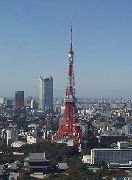
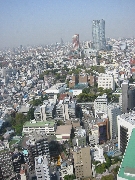
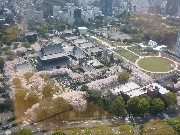
The tour bus company picked us up
at 8 AM in front of our hotel, drove
us to their depot, and we transferred to the tour bus.
The trip included a visit to the observation deck
of the Tokyo Tower,
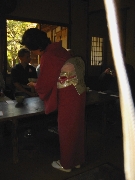
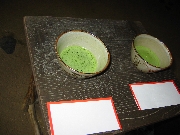 an abbreviated tea
ceremony,
a barbeque(?!), a drive by the Diet (Parliament building)
and through Ginza shopping district, a boat
cruise of the Sumida river, a walking tour of the Asakusa
Kannon Temple
and the relentless nearby tourist shopping, and a visit to the gates of
the Royal Palace.
an abbreviated tea
ceremony,
a barbeque(?!), a drive by the Diet (Parliament building)
and through Ginza shopping district, a boat
cruise of the Sumida river, a walking tour of the Asakusa
Kannon Temple
and the relentless nearby tourist shopping, and a visit to the gates of
the Royal Palace.
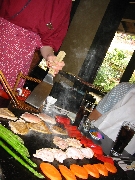
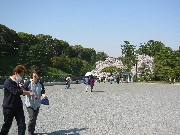
Tokyo
is a huge city, measuring some fifteen by fifty-five miles. No two streets are alike.
Indeed, no street goes two blocks without
completely changing character. It is a
very clean city. There was never any
hint of danger, even in the middle of the night.
A week in Japan
and the differences between our culture and theirs begin to become clear.
While both have their strengths and
weaknesses, seeing other societies that “work” is fascinating and enlightening.
Sunday
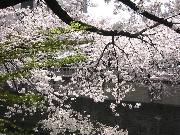
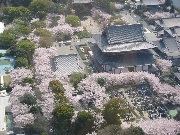
Last day. We got up
late for the first time and spent an hour packing. Neil wandered around Hibya
park, across from the hotel.
Did we mention the cherry blossoms? We arrived
at the height of cherry blossom season and the country was everywhere a riot of
white and pink-draped trees. Truly
breathtaking.
There are some 60
varieties of cherry blossoms.
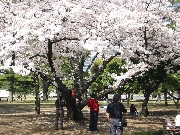
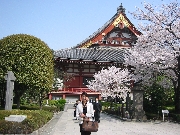
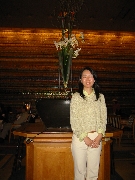 Three
hours before we were to leave, we got a wonderful call from Chise
Uozomi. She is
Teruyo and Toshihiro’s daughter. Neil
saw her in 2003, but Sue hadn’t seen her since she was 6 years old, back in
1981. Chise
had just returned to Tokyo from a
friend’s wedding and was hoping to see us.
We spent our last two hours in Tokyo
with her.
It was heartwarming to see her and catch up on her life. We all left in tears.
Three
hours before we were to leave, we got a wonderful call from Chise
Uozomi. She is
Teruyo and Toshihiro’s daughter. Neil
saw her in 2003, but Sue hadn’t seen her since she was 6 years old, back in
1981. Chise
had just returned to Tokyo from a
friend’s wedding and was hoping to see us.
We spent our last two hours in Tokyo
with her.
It was heartwarming to see her and catch up on her life. We all left in tears.
We flew
back via San Francisco and Detroit. On the leg from Narita to SFO, when we were
over Seattle, a call came over the
aircraft intercom, “If there is a doctor on board, would you please come to the
rear of the aircraft.” When Neil got his
doctorate (in astrophysics) back in the late 70’s, he was very self-conscious
of people calling him “doctor.” After all, he was not a “doctor” in the usual sense of the word. To overcome this discomfort, he became a
registered EMT and worked for 10 years on an ambulance (keeping his “day” job at the
University). He retired from the EMT biz when his writing career took off,
but that call on the airplane (3rd
time he has heard it) always brings him into action. The patient was a 42 year old woman who was
going toward the restroom when she suddenly collapsed. She had no vital signs (pulse or
respirations) when Neil and two (non-ER) MDs reached her. We began breathing for her and then doing a
few heart compressions and she responded by blinking and breathing on her
own. She faded a few times, but by
breathing for her using a bag-mask and giving her oxygen, she finally stabilized. How did Neil know the MDs were not
ER-trained? Neither of them knew how to
use the AED defibrillator, standard emergency equipment,
which they put aside when they couldn't figure it out.
The defibrillator will give a shock to a patient’s heart, but
only if they really need it – idiot-proof, but only if you use it!
© 2005 by Neil F.
Comins
![]() Japanese-language version of Neil’s book,
What if the Moon Didn’t Exist?
Japanese-language version of Neil’s book,
What if the Moon Didn’t Exist?
![]() and thought that it would be a good theme for the Mitsubishi
pavilion at the World Expo
2005. Mr. Abe (Abe-san, in Japanese)
asked if Neil would work with his company to pitch the idea in response to a
request for ideas from Mitsubishi. Neil
agreed and the concept was chosen from a field of over 30 proposals.
and thought that it would be a good theme for the Mitsubishi
pavilion at the World Expo
2005. Mr. Abe (Abe-san, in Japanese)
asked if Neil would work with his company to pitch the idea in response to a
request for ideas from Mitsubishi. Neil
agreed and the concept was chosen from a field of over 30 proposals. ![]() – just a bus, as
you can see – to the
Imperial Hotel
in Tokyo, about an hour and a
half away.
– just a bus, as
you can see – to the
Imperial Hotel
in Tokyo, about an hour and a
half away. ![]()
![]() It has a walk-around fireplace
in the common area and a hot spring spa outside. Getting to the spa requires changing footwear in the hotel, walking outside
in the cold for about 30 yards, and then entering the spa building. As you probably know, the etiquette of using
a spa is that you soap and rinse yourself well before entering the water,
naked. As is becoming more the custom,
the spa has separate baths for men and women.
These are sulfur spring waters; the odor is an acquired taste. We soaked first in an inside bath and then went
quickly into an outside bath and then back again. The view of the lake at sunset from the
outside bath is really stunning.
It has a walk-around fireplace
in the common area and a hot spring spa outside. Getting to the spa requires changing footwear in the hotel, walking outside
in the cold for about 30 yards, and then entering the spa building. As you probably know, the etiquette of using
a spa is that you soap and rinse yourself well before entering the water,
naked. As is becoming more the custom,
the spa has separate baths for men and women.
These are sulfur spring waters; the odor is an acquired taste. We soaked first in an inside bath and then went
quickly into an outside bath and then back again. The view of the lake at sunset from the
outside bath is really stunning. ![]()
![]()
![]()
![]()
![]()
![]()
![]()
![]()
![]() Among the other
dishes we had was
Among the other
dishes we had was ![]()
![]()
![]()
![]()
![]()
![]()
![]()
![]()
![]() First is a brief introduction under cover,
but not indoors, by two robots of a model called Wakamaru
that will be marketed for the first time next year. This part of the show is just in Japanese,
but the rest has the foreign-language translations mentioned above. Kids are fascinated by the robots that are
seen in many pavilions at Expo, most notably
First is a brief introduction under cover,
but not indoors, by two robots of a model called Wakamaru
that will be marketed for the first time next year. This part of the show is just in Japanese,
but the rest has the foreign-language translations mentioned above. Kids are fascinated by the robots that are
seen in many pavilions at Expo, most notably ![]() three of which are normal
movie theater screens, two of which are mirrors, and the one behind the
audience is a normal wall. Floor and
ceiling are also mirrors. Curtains hide
all but the front wall at first. For the
last five or ten minutes, the curtains draw back and if you look at the mirror
sides, you can see multiple reflections which gives a 3-D feeling to the
show. While Neil has had TV shows, radio
shows, and even planetarium shows developed based on his writings, this
pavilion is by far the most spectacular and creative work based on them to
date. They even had music commissioned for
the pavilion and the Brothers 4 (remember
them?) wrote a piece for the pavilion based on the theme of Neil’s book. Quite honestly, the whole thing brought tears
to our eyes.
three of which are normal
movie theater screens, two of which are mirrors, and the one behind the
audience is a normal wall. Floor and
ceiling are also mirrors. Curtains hide
all but the front wall at first. For the
last five or ten minutes, the curtains draw back and if you look at the mirror
sides, you can see multiple reflections which gives a 3-D feeling to the
show. While Neil has had TV shows, radio
shows, and even planetarium shows developed based on his writings, this
pavilion is by far the most spectacular and creative work based on them to
date. They even had music commissioned for
the pavilion and the Brothers 4 (remember
them?) wrote a piece for the pavilion based on the theme of Neil’s book. Quite honestly, the whole thing brought tears
to our eyes. ![]() There is also a picture of
Harrison Ford
in support of some aspect of the project.
There is also a picture of
Harrison Ford
in support of some aspect of the project.
![]()
![]()
![]() Mitsubishi went so far as to have wrapping paper
and shopping bags made in the theme of the pavilion.
It’s quite interesting to see your picture on thousands of
shopping bags! Yoshi explained that the
marketing people had expected very few of the books to be sold because they are
“scientific” rather than entertaining, even though they are written for the
public. It turned out that the marketing
people were wrong. In the first two
weeks, over 500 copies of the book were sold at the pavilion.
Mitsubishi went so far as to have wrapping paper
and shopping bags made in the theme of the pavilion.
It’s quite interesting to see your picture on thousands of
shopping bags! Yoshi explained that the
marketing people had expected very few of the books to be sold because they are
“scientific” rather than entertaining, even though they are written for the
public. It turned out that the marketing
people were wrong. In the first two
weeks, over 500 copies of the book were sold at the pavilion. ![]() Nevertheless, they traveled up to the Expo on
the day of Neil’s visit and, with Ohara-san’s help,
tracked
him down.
Nevertheless, they traveled up to the Expo on
the day of Neil’s visit and, with Ohara-san’s help,
tracked
him down. 









![]() Sue returned to the Mitsubishi pavilion and after a final walk around and talk
with people, Neil and Sue took their leave of the Expo, accompanied by Teruyo,
Yoshi, and Yuka
Fukahara, the architect of the pavilion’s interior. Another ride on the linimo brought them to a
waiting van, which drove them to Teruyo’s house to pick up luggage. This is not a trivial thing, since the house
is on a street that is only barely able to fit one car, and on a steep slope,
to boot.
Sue returned to the Mitsubishi pavilion and after a final walk around and talk
with people, Neil and Sue took their leave of the Expo, accompanied by Teruyo,
Yoshi, and Yuka
Fukahara, the architect of the pavilion’s interior. Another ride on the linimo brought them to a
waiting van, which drove them to Teruyo’s house to pick up luggage. This is not a trivial thing, since the house
is on a street that is only barely able to fit one car, and on a steep slope,
to boot. ![]() Japanese dinner. This restaurant is typical of many in the
cities of
Japanese dinner. This restaurant is typical of many in the
cities of ![]() After the tour, Neil, Sue, Abe, and
3 of his staff went to dinner at Ygkou Rakuo sushi restaurant. This was Neil’s
third visit to this tiny establishment, where fresh fish is brought in every
day and the food all melts in your mouth.
Among the best sushi on the planet. After a quick visit to a nearby Shinto shrine,
Neil and Sue returned to the hotel for an early evening, as Saturday, our
last full day in
After the tour, Neil, Sue, Abe, and
3 of his staff went to dinner at Ygkou Rakuo sushi restaurant. This was Neil’s
third visit to this tiny establishment, where fresh fish is brought in every
day and the food all melts in your mouth.
Among the best sushi on the planet. After a quick visit to a nearby Shinto shrine,
Neil and Sue returned to the hotel for an early evening, as Saturday, our
last full day in ![]()
![]() an abbreviated tea
ceremony,
a barbeque(?!), a drive by the Diet (Parliament building)
and through Ginza shopping district, a boat
cruise of the Sumida river, a walking tour of the Asakusa
Kannon Temple
and the relentless nearby tourist shopping, and a visit to the gates of
the Royal Palace.
an abbreviated tea
ceremony,
a barbeque(?!), a drive by the Diet (Parliament building)
and through Ginza shopping district, a boat
cruise of the Sumida river, a walking tour of the Asakusa
Kannon Temple
and the relentless nearby tourist shopping, and a visit to the gates of
the Royal Palace.
![]()
![]()
![]()
![]()
![]() Three
hours before we were to leave, we got a wonderful call from Chise
Uozomi. She is
Teruyo and Toshihiro’s daughter. Neil
saw her in 2003, but Sue hadn’t seen her since she was 6 years old, back in
1981. Chise
had just returned to
Three
hours before we were to leave, we got a wonderful call from Chise
Uozomi. She is
Teruyo and Toshihiro’s daughter. Neil
saw her in 2003, but Sue hadn’t seen her since she was 6 years old, back in
1981. Chise
had just returned to